One of the best ways to create a sustainable content strategy is by focusing on producing content that stands the test of time.
In other words, you need to embrace the power of evergreen content.
While trends, news articles, and other types of timely content have their place, their need for constant updating affects long-term business impact.
But when you have content without a shelf life supplementing your non-evergreen content, you’ve hit the jackpot.
If you’re looking for a more sustainable content marketing strategy, keep reading. In this article, we’ll review what evergreen content is and how to create valuable evergreen pieces for your target audience.
Let’s take a look.
What is Evergreen Content?
Evergreen content is quality content that remains relevant and valuable over an extended period of time. Creating evergreen content pieces is a great way to drive consistent traffic to your website or social media profiles and provide ongoing value to your audience.
These timeless pieces of content don’t lose relevance, no matter who accesses them or shares them.
Evergreen articles usually focus on topics that aren’t time-sensitive, such as educational guides, tutorials, industry insights, or tips that can be applied regardless of current trends.
For instance, it’ll always be true that brands should treat their customers with the utmost care and respect. And it’ll always be true that “solving problems” is the reason businesses exist.
Other topics that stand the test of time include psychology, design, and core marketing principles.
For example, the following blog post on insightful marketing books provides resources with a wealth of information for marketers. While some of the books focus on the latest industry trends, three of them cover time-tested marketing principles. These three are considered evergreen marketing books.
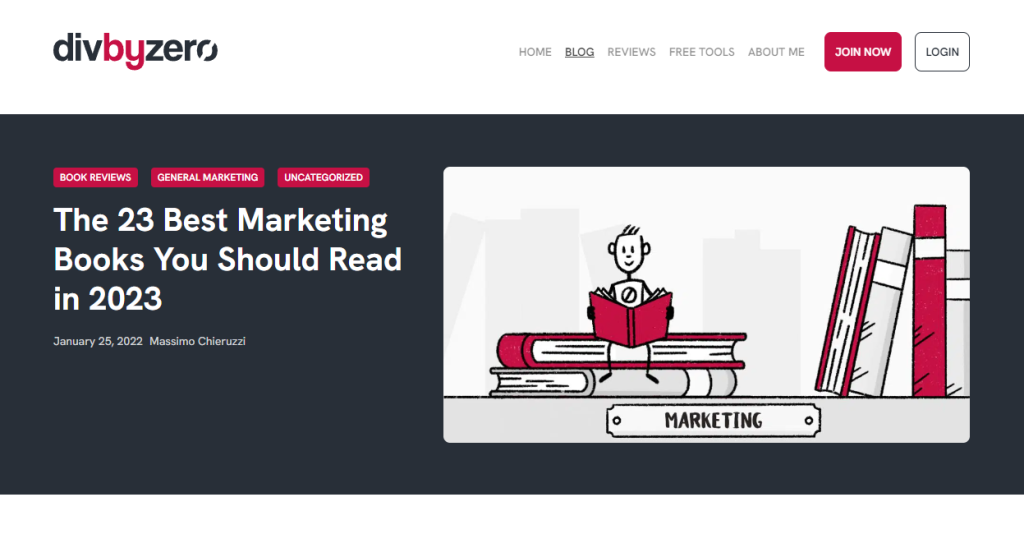
And here’s the jaw-dropper …
One of them was written in 1966! 😯
No wonder it’s considered a true evergreen masterpiece.

But … can a piece of content truly be “evergreen”?
Yes … and no.
If you believe in the saying “writing is never finished,” then every asset has room for improvement. Also, if data or core information changes, you’ll need to update the piece to keep the content fresh.
To maintain an evergreen “feel,” schedule quality analysis (QA) checks to update your assets as information changes. More on this in a bit.
The Importance of Evergreen Content in Building Brand Authority
Building brand authority is a must in an increasingly online world. One of the ways to establish this authority and earn the trust of your audience is by producing evergreen content.
Why does evergreen content play such a significant role in building brand authority?
- Credibility: When audiences repeatedly come across your content that offers timeless advice, your brand’s credibility naturally grows. They begin to see you as a reliable source of information on the subject matter.
- Engagement: Evergreen content keeps your content interactive. Be it through comments, shares, or likes, a piece that remains relevant for years will garner more engagement over time.
- Organic search traffic: Evergreen content is SEO gold. As more users find your content organically, your brand’s digital footprint and authority expand, boosting your SEO.
- Time and resource efficiency: Instead of continuously creating new content, evergreen content allows you to focus on quality over quantity. The result? You can spend your time and resources on other high-priority tasks.
Here’s a great example of how Moz put evergreen content to good use. They’ve captured the top spot on the search engine results page (SERP) with a post that’s over four years old. The best part? It drives 2,233 organic traffic to their blog every month.

Types of Evergreen Content
While we’ve discussed the concept of evergreen content, it’s essential to dive deeper into the different types you can incorporate into your strategy.
Here are some of the most common categories:
- How-to Guides: These are detailed instructional content pieces. For instance, “How to Start a Business: Step-by-Step Guide” will always be relevant for budding entrepreneurs.
- Listicles: Articles that list out “Top 10” or “Best of” items or ideas. An example would be “Top 10 Marketing Strategies Every Small Business Should Know.”
- Glossaries: Explaining industry-specific terms. A glossary of digital marketing terms, for instance, would have a long shelf life.
- Testimonials and case studies: Real-life examples of how your product or service has helped others. While some specifics might change, the core message of the value you provide remains evergreen.
- Checklists: These are concise and actionable items that readers can follow. For example, “Checklist for Launching Your Online Store” is a timeless piece.
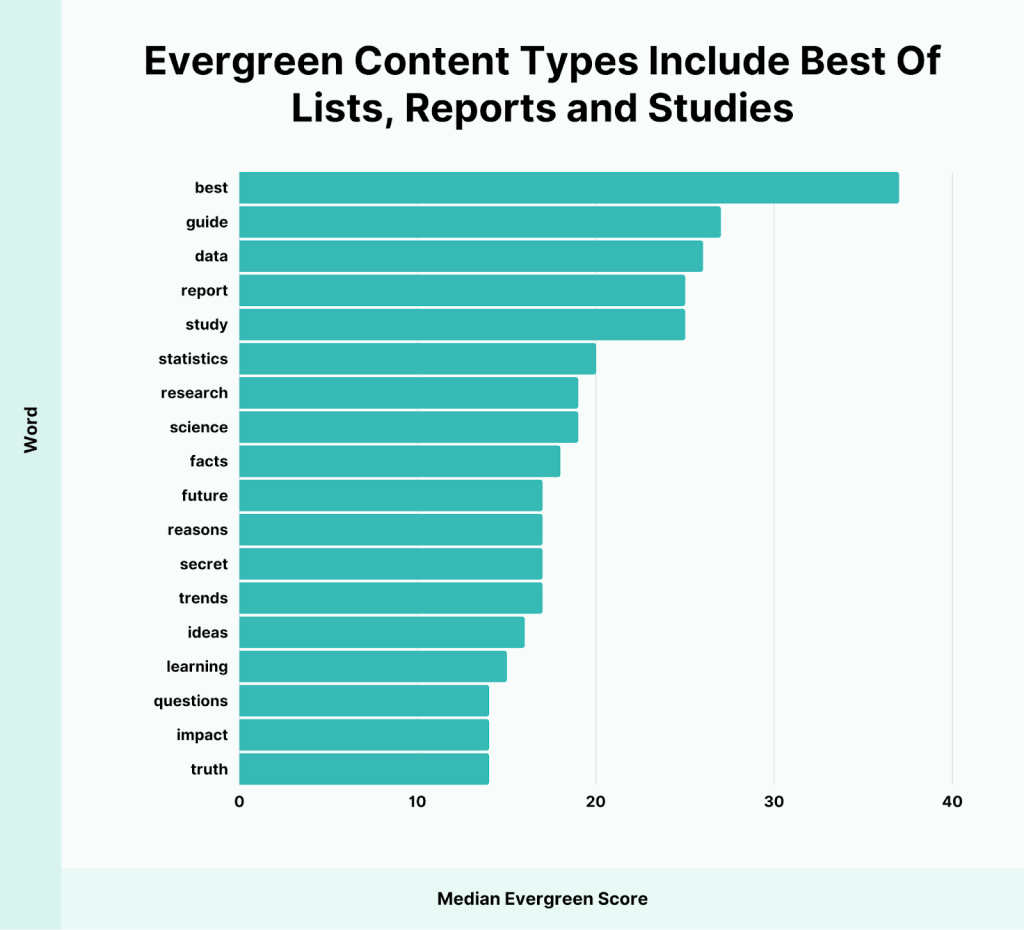
Now, don’t underestimate the power of integrating images, infographics, and videos to elevate your evergreen content.
Here are some tried-and-true methodologies that help give your content that extra pizazz:
- Infographics: Engaging infographics break down complex information into digestible visual pieces. They’re highly shareable and can explain complicated concepts simply.
- Videos: Video content can showcase product demonstrations, interviews, or educational content. Remember, “show, don’t tell” is an effective approach to content marketing.
- Images with annotations: These can be screenshots, photos, or any image that further explains or emphasizes your content.
Ahrefs does this particularly well. They use a combination of all three visuals across their evergreen blog posts.
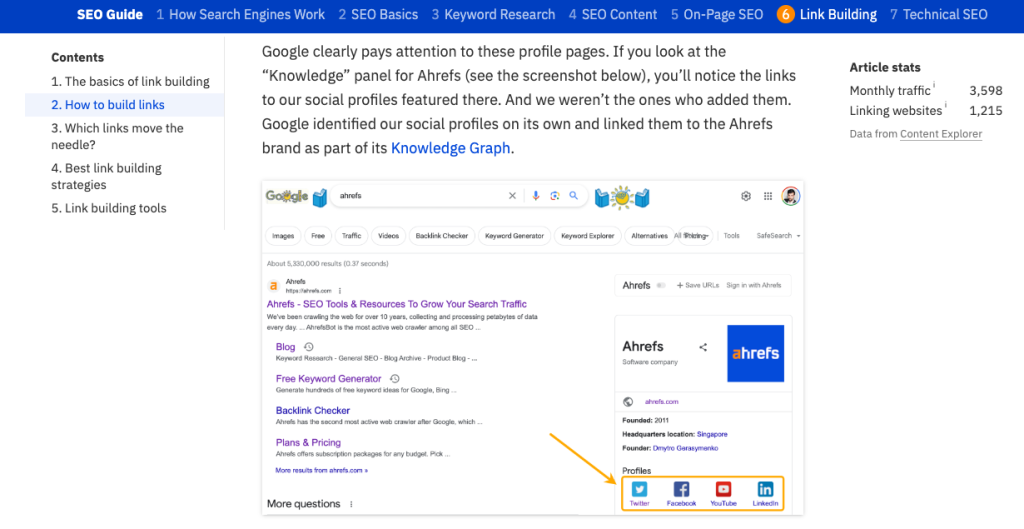
Adding these extra visuals helped them increase organic traffic to almost 700,000 monthly visits. But that’s not it. They’re one of the go-to sources for search engine optimization and link-building information.
The value? Priceless.
5 Steps To Create An Evergreen Content Strategy
Now that we’re clear on what evergreen content is, let’s review how to create an evergreen content strategy in five simple steps.
1. Identify Your Audience and Customer Segments
To produce quality evergreen content, start by outlining your niche audience and individual customer segments.
For instance, your niche audience might be “designers and creators.” And your customer segments might be:
- Graphic designers
- Web designers
- Content creators
Or, your audience could be “people who need project management software.” And your customer segments might be:
- HR directors
- Project managers
- Product designers
If you have a super niched down audience, i.e., HR directors, then your segments might be:
- HR directors in the tech industry
- HR directors in the marketing industry
- HR directors in the higher education industry
After identifying and segmenting your audience, it’s time to strategize relevant content topics.
Which brings us to …
2. Identify core evergreen topics
Dig deep into each of your customer segment’s needs and pain points.
What are they struggling with? How can you help them better than your competition can?
Consider the “designers and creators” audience we referenced above.
Let’s imagine the following pain points for each customer segment:
- Graphic designers: Struggling to find a reliable resource for design inspiration, tips, and tricks.
- Web designers: Need help managing clients, web design principles, and web design portfolios.
- Content creators: Tired of relying on YouTube tutorials for video and audio creation advice. They need a trustworthy source to uplevel their video content.
Based on each segment’s pain points and core needs, strategize relevant keywords, such as:
- Segment 1: Logo design, branding, visual design, fonts and illustrations, best graphic design, graphic design tips
- Segment 2: User experience design, responsive design, managing web design portfolios, managing web design clients
- Segment 3: Video editing tips, video design tips, video design, video editing, video filters, podcasting, sound effects, social media marketing
Next, conduct keyword research to finalize your target keyword list. These are the main topics you’d like search engines to rank you high for so you can generate organic traffic to your website.
To create a successful SEO optimization strategy for your upcoming evergreen posts, aim for topic keywords with low competition and a consistently high search volume. This means you’ll be writing about topics that a lot of people search for that many websites don’t cover. This gives you the chance to put your best foot forward without having to worry about competing with big-name publishers.
Once you have your final list in hand, name it your “target keyword” list. You’ll use this to center each evergreen blog content around a main topic keyword. You’ll also plug these main topics into your SEO optimization tools like Surfer to uncover secondary keywords for each target keyword. Be sure to sprinkle these secondary keywords where relevant to fully optimize each piece of content.
To increase your chance of ranking with search engines, aim for a high SEO content score — as close to 100% as you can — without sacrificing quality. At the very least, aim to surpass the average competitor score. (You’ll find the average content score for each main topic in your optimization tool.)
But before you get started on optimization, let’s dig a little deeper into your content strategy.
3. Plan evergreen topic clusters
With your topic list in hand, consider which topics will be your evergreen “pillars” and which ones will be your evergreen subtopics.
Pillar pieces with subtopic pieces nestled underneath are considered “topic clusters”. These are prime SEO real estate opportunities because they:
- Categorize your content
- Reflect subject-matter expertise
- Help each customer segment find valuable resources to solve their problems
For example, your evergreen pillar topics could be:
- Graphic Design
- Web Design
- Video and Audio
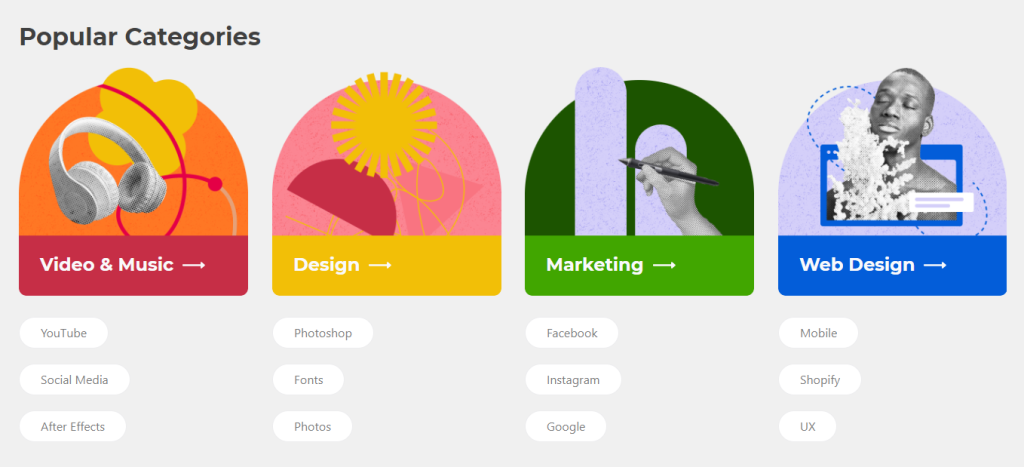
And your evergreen pillar pieces could be:
- “The Graphic Designer’s Ultimate Guide 10 Principles That Never Go Out of Style”
- “The Art of Clean Web Design — Why Simple Will Always Beat The Ultra-Creative”
- “Video And Audio Mastery: How To Create Video And Audio Content That Leave a Lasting Impact On Your Audience”
After strategizing your evergreen article ideas for your pillar topics, use the following template to plan your clusters and subtopics:
“User Segment ▶️ Pillar topics ▶️ Pillar pieces ▶️ Subtopics”
Here’s an example:
Graphic Designers ▶️ Graphic Design ▶️ The Graphic Designer’s Handbook ▶️ Evergreen Logo Design, Evergreen Branding Principles, Evergreen Illustration Design
4. Plan evergreen lead magnets and resource guides
At this point, you know what pillar topics and subtopics you’ll be targeting. You also have evergreen content examples in mind for your pillar pieces.
But you also need to strategize assets for your subtopics.
Here’s where lead magnets and resource guides come into play.
Lead magnets, or gated content assets, are articles and guides you create to generate leads. Prospects must supply their contact details or sign up for your newsletter in exchange for the free content you’ve created. Once you have their information, you’ll not only have a growing lead list, but you can also set up automated lead nurturing campaigns with your email marketing tool.
You can add lead magnets:
- On your website
- In your social media bios
- On your landing pages
- In your email signature
This strategy is an effective way to automate the process of getting fresh leads and converting them into customers.
Resource guides, on the other hand, are great for bottom-of-the-funnel leads, new customers, and established customers. They can also help your business decrease unnecessary customer support inquiries and protect the customer experience.
For example, Tailor Brands wrote a guide covering the top information on LLC formation. LLC frameworks always stay the same, minus minor updates, which gives this topic a timeless quality.
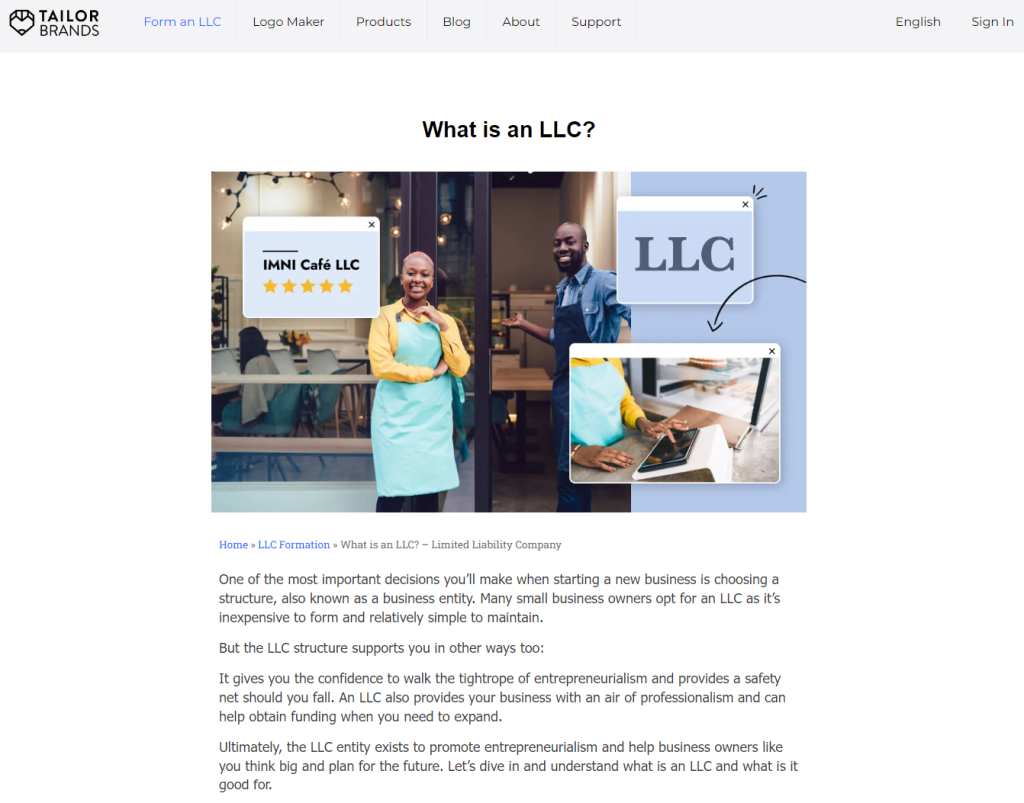
Articles like these remain relevant and valuable to entrepreneurs and small business owners year after year due to several key factors:
- Stable legal framework: The process of setting up an LLC follows a stable and well-defined legal framework. While some minor regulations may change, the fundamental steps and principles of LLC formation remain largely consistent, ensuring the longevity of the content.
- Universal relevance: The need to establish an LLC is universal for businesses seeking limited liability protection and a flexible business structure. This relevance transcends industry trends and economic fluctuations, making the information perpetually useful.
- Continuous demand: As entrepreneurship continues to thrive, there’s a constant demand for information on LLC formation. New entrepreneurs and business owners consistently seek guidance on this topic, ensuring an ongoing audience for Tailor Brands’ evergreen content.
- Timeless guidance: Tailor Brands’ articles offer timeless guidance, addressing core aspects such as selecting a business name, filing paperwork, and understanding the benefits of an LLC. This advice remains valuable to anyone on an LLC formation journey.
- Updated information: While the core concepts remain constant, Tailor Brands can update their articles with any relevant legal changes or procedural updates. This ensures that the content remains accurate and trustworthy over time.
Aspiring entrepreneurs and business owners will continue to turn to these resources for valuable insights and step-by-step guidance, cementing their status as evergreen content.
Let’s take a look at another evergreen guide and dig a bit deeper into why it works.
For example, LOVO AI, a text-to-speech software, wrote a listicle guide describing the best AI tools for businesses, which references:
- How AI is revolutionizing marketing
- AI image generators
- AI content tools
- AI email tools
- AI SEO tools
- Text-to-speech (TTS) AI

This informative guide is a great example of an evergreen asset that’ll stand the test of time. The only changes LOVO would need to make in the future may be some updates to the list as new tools emerge. Simple measures to keep the content fresh.
Now imagine an entire library of assets like these. Fully optimized. Tailored to your audience. And structured to pull the eye down. Talk about a winning content strategy.
Over time, a collection of high-quality evergreen content like this can not only attract relevant customers but can also help your website increase its domain score. In other words, you’ll be actively investing in your website’s authority and expertise — a strategy that can pay off for years to come.
And now that you’ve planned your lead magnets and guides, it’s time to …
5. Schedule time to write, publish, and refresh your evergreen content
Turn your insights into action by creating a content publishing calendar to support your evergreen content marketing campaign.
In your calendar, carve out enough time to:
- Hire ghostwriters and subject matter experts for support
- Create content briefs for your writers
- Give your writers a proper deadline for each piece
- Manage the editing and staging process
- Create a library full of evergreen assets
You’ll also need to choose publishing dates and build in time to refresh your evergreen content. For example, add a reminder or automated alert to refresh each article every six months. If a refresh isn’t needed after six months, schedule another check-in six months later.
Or, better yet, add more content to your published evergreen pieces. Search engines appreciate content additions and updates that increase an article’s value.
To make your additions meaningful to each asset, you could:
- Weave in trust elements
- Add social proof
- Include an FAQ section
- Add mini-case studies
- Include expert quotes and sources
- Include valuable media, such as videos, photos, screenshots, and infographics
Don’t forget the power of data. Using Google Analytics, monitor which pieces of your evergreen content are driving the most traffic, which ones are most shared, and which ones have the most extended average view times.
Based on this data:
- Refresh: Update your most popular pieces with fresh information or visuals.
- Repurpose: Transform a well-performing blog post into a video or infographic.
- Promote: Re-share your top-performing evergreen content across social media platforms periodically.
Here’s a great example from HubSpot, where they’ve updated a post originally published in 2019 with new information for 2022.
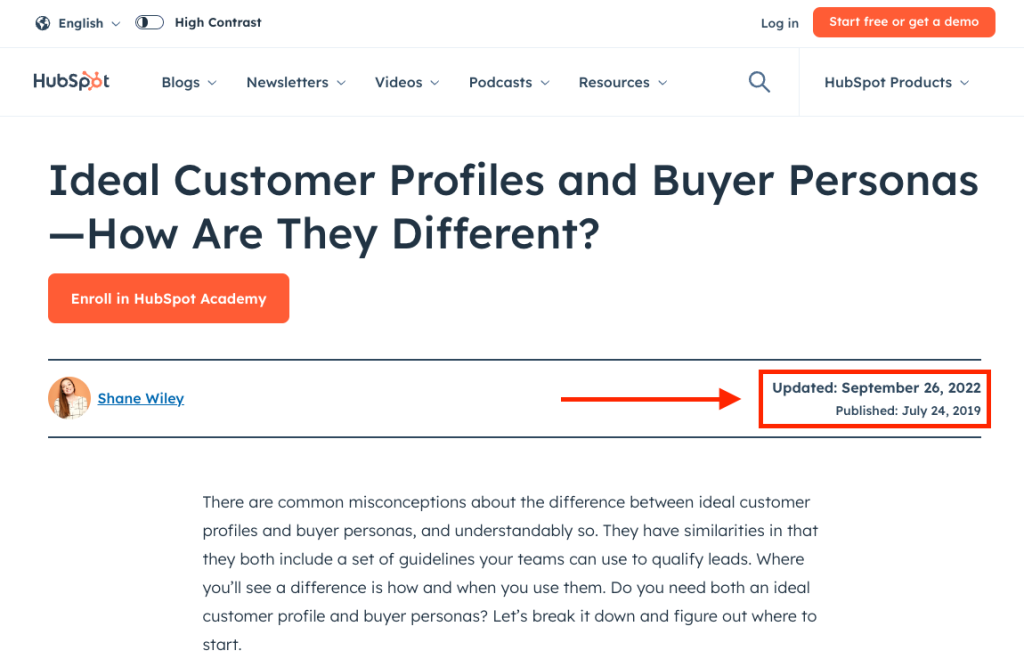
Wrap up
Expanding on the principles of evergreen content, it’s clear that such a strategy isn’t just about creating timeless content. It’s about building a legacy of trust, authority, and value in your niche or industry.
Crafting evergreen content requires intention and strategy. By following the steps we’ve outlined in this article, you can create quality evergreen content your target audience will always value.
Remember, to create evergreen content, you’ll need to:
- Identify your audience and customer segments
- Identify core evergreen topics
- Plan evergreen topic clusters
- Plan evergreen lead magnets and resource guides
- Schedule time to write, publish, and refresh your evergreen content
The investment you make in evergreen content today can reap dividends for years, amplifying your brand’s voice and positioning in the market.
Continue on this journey, and soon, your brand will be synonymous with reliability and expertise in your domain. And that, in the end, is the true power of evergreen content.
That’s it for now. Good luck with your evergreen content strategy! 🚀
PS: Craving more content marketing tips? We’ve created a content marketing blog just for you! Head on over for more inspiring tips and tricks.
Frequently asked questions
1. What exactly makes content “evergreen”?
Evergreen content is essential information that remains continuously relevant and doesn’t become outdated or obsolete.
Why? The topic is universal, such as basic principles of human psychology or foundational business practices. It’s content that’s always in demand regardless of current events or seasonal trends.
2. How often should I update my evergreen content?
While evergreen content remains relevant for a long time, it’s good practice to review and refresh these pieces periodically, at least every 6–12 months.
This schedule guarantees that any minor changes, updates, or new insights can be incorporated, keeping the content fresh and accurate. Regularly updating your evergreen content also signals to search engines that the content is still relevant and valuable.
3. Can news or trending topics ever be considered evergreen content?
Generally, news or trending topics are time-sensitive and might not remain relevant for an extended period. However, some news stories or trends might evolve into larger conversations or themes that have lasting relevance.
In such cases, while the immediate news might fade, the overarching subject or theme might be worthy of an evergreen piece. It’s about distilling the timeless elements from transient events.
